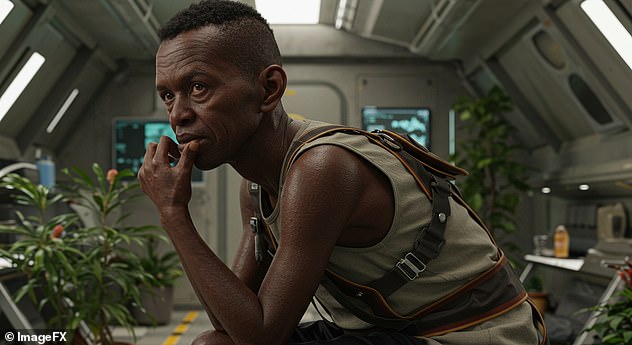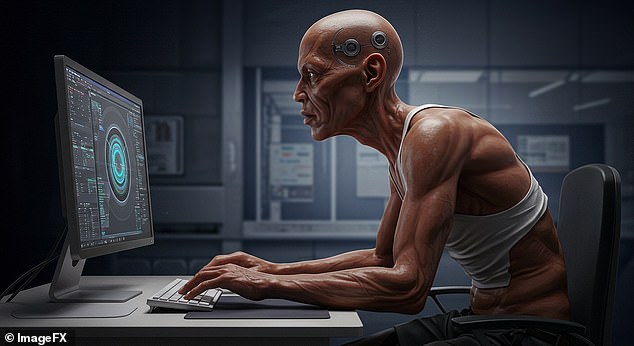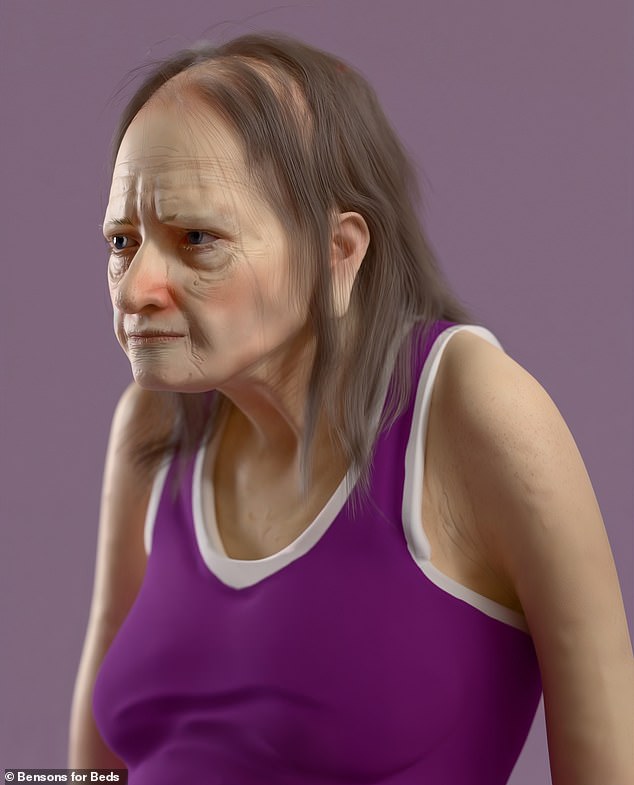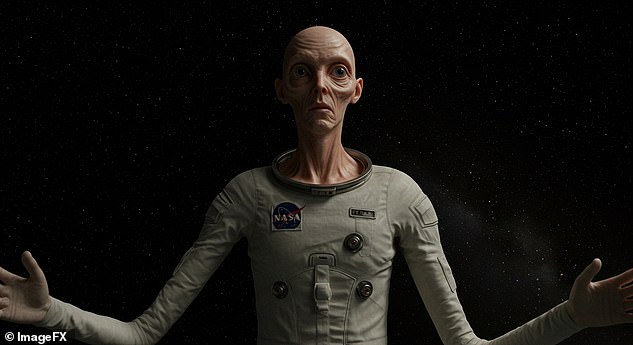Looking back at our primate ancestors, it would be easy to assume that humans today have reached the final chapter of our evolution.
However, many scientists believe that the way humans appear today is just the start of the story.
Thanks to technology, space travel, and climate change, the world around us is changing faster than ever – and experts believe that humanity will change with it.
Now, artificial intelligence (AI) reveals what the humans of the future might look like.
With Google‘s ImageFX AI image generator, MailOnline has used predictions from leading scientists to imagine how the human race might evolve.
According to the experts, humans will look a lot more uniform in the future.
They predict the average person will have darker skin and look more like someone from the modern-day cultural melting pots of Mauritius or Brazil.
And, in good news for everyone, experts say that the humans of 3025 could be more attractive than we are today.


People will be shorter
In the past, the biggest force driving evolution came from humans dying before they had the chance to reproduce and pass on their genes.
However, thanks to modern medicine, more and more people are living long enough to have children.
This means that a different force will determine which genes become more common.
Professor Mark Thomas, an evolutionary geneticist from UCL, told MailOnline: ‘In the past that has always worked on some children not surviving, but the point is that evolution also works on fecundity – on how many children are born.’
Essentially, this means that people who have more children are more likely to pass on their genes.
Interestingly, some scientists have suggested that this could make humans shorter in the future.
While Professor Thomas is clear that this is just ‘one theory among many’ it has been proposed that early sexual maturation has been linked to smaller height.


Reaching sexual maturity early allows organisms to have more offspring across their lifespan but this appears to be traded off against decreased size.
Professor Thomas says: ‘This is one of the arguments that’s been put forward to explain why you get pygmy populations in many places around the world.
‘Their lives are relatively short because it’s a tough life in the rainforest, so they’ve traded off sexual maturation against physical growth.’
If people who mature earlier end up having more children, the genes which cause both early maturation and shorter stature could increase in the population.
However, Professor Thomas stresses that this idea hasn’t been tested in population studies so the connection may not hold outside of specific environments.
More attractive
As fewer people die, the biggest factor driving evolution will be how many children someone can have.
Strangely, one potential effect of this is that it might end up making men more attractive.


Professor Thomas says: ‘The natural state of affairs in mammals is really for females to do all the choosing.
‘But when you have strong patriarchies, as we do in many places around the world, then the males end up doing a lot of the choosing and controlling.’
As societies liberalise and women become increasingly able to choose their own partners that selective pressure could be piled back on.
‘Thankfully we’re moving into a world where females do the choosing, and they’re going to choose males who they like for one reason or another,’ says Professor Thomas.
‘It might be for brains, success, because they look good, or look muscly but as there’s more female choice you would expect those traits to increase.’
So, over the next few thousand years, as more attractive men pass on their genes more successfully, humanity might get that little bit more handsome.
Darker skin and more uniform looks
One of the biggest changes that experts expect to see is that humanity will become much more uniform in appearance.

For large parts of human history, individual populations have remained relatively isolated from one another.
When small isolated groups like the Amish breed together the rate of genetic drift, random fluctuations in gene frequencies, tends to be higher, making them more distinct from other populations.
However, compared to the past, people from different ethnicities are already mixing together much more often.
Dr Jason Hodgson, senior lecturer on bioinformatics and big data at Anglia Ruskin University, told MailOnline: ‘One thing that might happen in the future is the breaking down of population structure.
‘Current trends in the US, at least, suggest that interracial marriages are becoming more common. Assuming this pattern continues you will see less population structure.’
On an individual level, this means the average human of the future will become more genetically diverse since they will inherit traits in a greater number of populations.
However, at the population level, this could lead to less variation.
‘In terms of appearance, you would then see that people are more intermediate,’ says Dr Hodgson.

‘If we think about one of the few traits that varies by population – skin colour – most people would be a bit brown, for example.’
Professor Thomas points out that a good point of reference would be the modern population of Brazil or Mauritius where lots of ethnic groups have already mixed for several generations.
Technologically enhanced
Powerful new technologies might give humans the ability to shape our own evolution.
Dr Hodgson says: ‘I would question whether evolution will be allowed to proceed naturally in the distant future.
‘We currently have the technology to do targeted gene editing with CRISPR-Cas9. This gives us the ability to largely change the genome as we want.’
Although Dr Hodgson points out that almost all scientists today consider this to be unethical, future generations might not be so scrupulous.
There are already companies offering ‘designer baby’ services in the US which claim to help parents select for traits like height, intelligence, and gender.

If these technologies are allowed to spread without check, then genetic traits that were once rare in the population could become significantly more common.
Dr Hodgson says: ‘In the distant future you might see very significant change, and it could potentially happen on the scale of a single generation.’
Using technologies like CRISPR-Cas9, which allows scientists to cut and paste sections of DNA, humans might even be able to take on new genetic traits from elsewhere in the animal kingdom.
For example people might choose to give themselves darker skin with higher levels of melanin to help protect against harmful UV radiation.
Fashions and cultural trends will also change the way people look as technology lets people choose more about their appearance.
Dr John Hawks, an anthropologist from the University of Wisconsin-Madison, told MailOnline: ‘If we look to the future, the cultural and technological changes are almost certainly going to be stronger than the genetic changes across humanity.
‘Many of those affect appearance: you can imagine color-changing tattoos, all kinds of body modification, new modes of expression that come from blending bodies with technology.’
Smaller brains

Professor Robert Brooks, an evolutionary biologist from the University of New South Wales, Syndey, told MailOnline he would expect to see human brains get smaller over time.
Professor Brooks’ theory suggests that as computers take over more of the computational, factual, and social dimensions of living, the advantage of having a big brain decreases.
At the same time, the energy cost to mothers of bigger brains and the increased risks during childbirth due to larger heads remain the same.
Writing for The Conversation, Dr Nicholas Longrich, a palaeontologist and evolutionary biologist from the University of Bath, compared humans’ future development to that of a domesticated animal.
Dr Longrich wrote: ‘Arguably we’re becoming a kind of domesticated ape, but curiously, one domesticated by ourselves.’
He continues: ‘Sheep lost 24 per cent of their brain mass after domestication; for cows, it’s 26 per cent; dogs, 30 per cent.
‘This raises an unsettling possibility. Maybe being more willing to passively go with the flow (perhaps even thinking less), like a domesticated animal, has been bred into us, like it was for them.’
Hunched backs and clawed hands

Other studies have suggested that increased use of technology could lead to other non-evolutionary changes.
This could include humans having more pronounced hunches from looking at computers all day or developing crooked and overdeveloped hands from using phones.
Likewise sleep expert Dr Sophie Bostock previously predicted that humans missing out on sleep could begin to have big changes on our bodies.
As we spend more time using technology and social media, more people may end up getting six hours or less of sleep.
In 25 years, Dr Bostock predicts that the average Briton will have chronic back pain, thinning hair, sagging skin, swollen legs and red, baggy eyes.
They will also suffer from thinning muscle in the arms and legs and become increasingly prone to flu due to a weak immune system.
However, these changes wouldn’t occur at the genetic level since there would be no evolutionary advantage to pass them on.
Adaptations for space


If some part of humanity were to venture into space, it is not entirely inconceivable that this group would slowly evolve away from the population remaining on Earth.
Dr John Hawks, an anthropologist from the University of Wisconsin-Madison, told MailOnline: ‘The human population of Earth is very large and diverse, but long-term space travel does create the potential of small founder populations that remain separated for millennia.
‘Establishing a sustainable human population in another star system after a voyage of thousands of years would not be easy. But such a scenario would give rise to the possibility of speciation.’
On Mars, humans would receive only 66 per cent of the sunlight and 38 per cent of the gravitational force they are exposed to on Earth.
To adapt to space, humans might become taller and develop longer arms in order to perform better in low gravity.
Even on the International Space Station, NASA says that astronauts can grow by about three per cent in the first few days in space as their spines strech out in low gravity.
Likewise, just as was the case when ancient humans migrated into northern Europe, future humans could become paler in order to maximise the amount of vitamin D derived from low light.
Human eyes could also become bigger and more sensitive to see in dim conditions or be enhanced with a number of technological augmentations.

